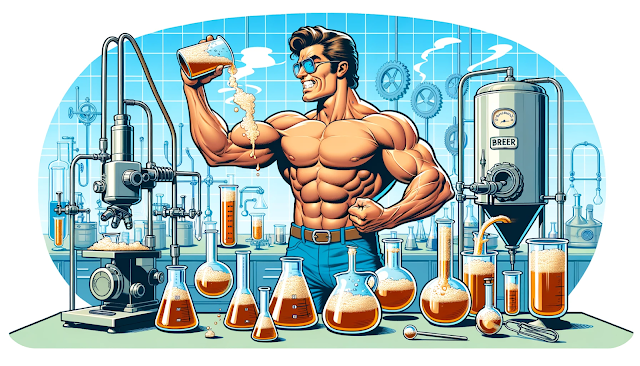You're in the right place.
We know a thing or three about sanitizer.
The essence of a flavorful beer lies not just in the ingredients but also in the cleanliness and sanitation of your equipment. Any seasoned homebrewer will emphasize the importance of immaculate equipment and bottles to ward off any undesirable bacteria that might ruin your concoction.
Recall a time when your brew was compromised due to insufficient cleaning? You beer was wrecked as it was infected?
The essence of a flavorful beer lies not just in the ingredients but also in the cleanliness and sanitation of your equipment. Any seasoned homebrewer will emphasize the importance of immaculate equipment and bottles to ward off any undesirable bacteria that might ruin your concoction.
Recall a time when your brew was compromised due to insufficient cleaning? You beer was wrecked as it was infected?
It's an agonizing experience, isn't it?
You spend the time and money on malt, yeast and hops and then it's simply undrinkable acid.
Want no fuss, just need the good stuff? The good oil on sanitizer? Regardez-vous:
Let's dive in and explore the top sanitizers that will shield your beer, cider, or wine from any brewing adversaries.
Star San is renowned for its formidable ability to annihilate any microorganisms threatening your brew. Characterized by its makers as "a self-foaming acid sanitizer apt for brewing, dairy, and other edibles," it stands out as a potent bactericide and fungicide.
1. Star San: The Pinnacle of Sanitizers
Star San is renowned for its formidable ability to annihilate any microorganisms threatening your brew. Characterized by its makers as "a self-foaming acid sanitizer apt for brewing, dairy, and other edibles," it stands out as a potent bactericide and fungicide.
What's more, it's resilient against excessive organic soils and diminishes water spotting. Comprising phosphoric acid and dodecylbenzenesulfonic acid, Star San is a no-rinse solution — a significant advantage for brewers eager to get brewing.
Usage: Star San can be applied through spraying or soaking equipment and bottles. A ratio of one ounce to 5 gallons of water ensures optimal protection against bacteria.
However, its superiority comes with a premium price tag.
2. Iodophor: The Trusted Choice
Iodophor, favored by the beer brewing community, has roots in the food service and medical sectors for equipment sanitation. A trifecta of detergent, germicide, and sanitizer, Iodophor promises sanitation in approximately 10 minutes. As with Star San, it requires no rinsing at the suggested concentration.
A word of caution: Iodophor can stain clothing, so exercise care during use.
3. Powdered Brewery Wash (PBW)
Originally embraced by commercial breweries, PBW has won the hearts of homebrewers for its sanitizing prowess. Many veteran brewers laud its effectiveness. PBW not only sanitizes but also aids in removing beer labels from bottles.
A tip: You can craft your own PBW alternative using household products. Blend a home brand like Tide or Oxiclean with a metasilicate-rich cleaner like Red Devil TSP/90 in a 70/30 mix to craft a DIY sanitizer.
Usage: Star San can be applied through spraying or soaking equipment and bottles. A ratio of one ounce to 5 gallons of water ensures optimal protection against bacteria.
However, its superiority comes with a premium price tag.
2. Iodophor: The Trusted Choice
Iodophor, favored by the beer brewing community, has roots in the food service and medical sectors for equipment sanitation. A trifecta of detergent, germicide, and sanitizer, Iodophor promises sanitation in approximately 10 minutes. As with Star San, it requires no rinsing at the suggested concentration.
A word of caution: Iodophor can stain clothing, so exercise care during use.
3. Powdered Brewery Wash (PBW)
Originally embraced by commercial breweries, PBW has won the hearts of homebrewers for its sanitizing prowess. Many veteran brewers laud its effectiveness. PBW not only sanitizes but also aids in removing beer labels from bottles.
A tip: You can craft your own PBW alternative using household products. Blend a home brand like Tide or Oxiclean with a metasilicate-rich cleaner like Red Devil TSP/90 in a 70/30 mix to craft a DIY sanitizer.
4. Laundry Soakers: The Unexpected Savior
Surprisingly, common laundry soakers can serve as sanitizers. Products boasting 'oxy' labels typically contain sodium percarbonate, a chief ingredient in many renowned soakers. We can personally testify that this is the key product we use to prepare our beer bottles and brewing drum - it's cheap an effective.
5. Bleach: The Old Reliable
Bleach, while commonplace, can be a potent sanitizer for homebrewing. A solution of 1 tablespoon of bleach to 1 gallon of water, followed by a 20-minute soak, should suffice. However, due to its strong odor, rinsing is advised. For quick results, opting for faster-acting solutions like Star San might be more prudent.

The Verdict on the best beer making sanitizers
When it comes to selecting the ideal homebrewing sanitizer, consider these factors:- Premium quality and user-friendliness come at a price, making PBW and Star San top contenders.
- For a mid-tier option, products containing sodium percarbonate are recommended.
- For those on a budget seeking extended sanitization, traditional bleach is a viable choice.
In the realm of brewing, cleanliness is paramount. So, embark on your brewing journey with the best sanitization practices in tow!


.png)